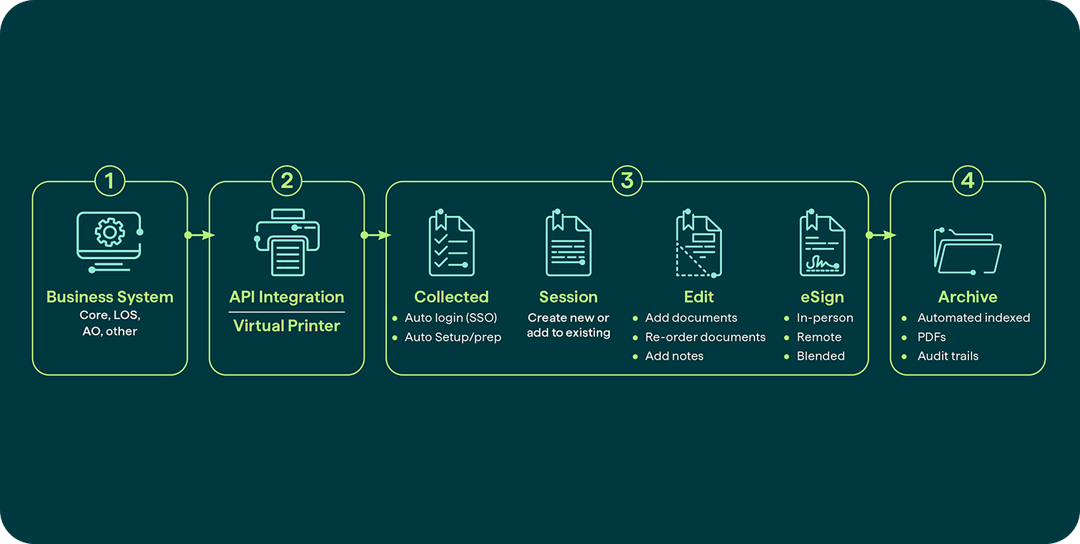eSIGNATURES 101
Everything you need to know about electronic signatures.
The way banks and credit unions conduct business seems to be changing daily, but one thing is certain: printing, signing, and scanning documents is officially old-school. Electronic signatures streamline document workflows, enhance efficiency, and reduce paper waste. Electronic signatures, often referred to as e-signatures, are digital equivalents of handwritten signatures. They are used to sign electronic documents securely, eliminating the need for pen and paper.
Here are answers to the most common questions associated with electronic signatures.

What are electronic signatures?
Electronic signatures, also known as e-signatures, serve as the digital equivalent of handwritten signatures, offering banks and credit unions a convenient way to sign documents without the hassle of traditional methods.
Whether it’s typing a name, uploading a scanned signature, or utilizing a digital signature, e-signatures streamline paperwork processes across various banking operations. These signatures carry legal validity, backed by regulations such as the Electronic Signatures in Global and National Commerce (ESIGN) Act in the U.S. and the eIDAS regulation in the EU. Embracing e-signatures allows banks and credit unions to enhance operational efficiency and compliance standards, ensuring seamless document management in the digital age.
How do electronic signatures work?
An electronic signature offers a swift, straightforward, and secure method for signing digital documents. While some may mistakenly label them as “online signatures,” electronic signatures are subject to stringent legal and technical requirements to ensure their validity. Comparable to wet signatures, electronic signatures find application in a wide array of scenarios, spanning from sales contracts and offer letters to account openings and invoices. However, unlike their traditional counterparts, electronic signatures boast heightened efficiency, mobile accessibility, and fortified security through digital encryption methods.
In the United States, the Electronic Signatures in Global and National Commerce Act (ESIGN) provides the legal framework for electronic signatures, defining them as “an electronic sound, symbol, or process, attached to or logically associated with a contract or other record and executed or adopted by a person with the intent to sign the record.” In simpler terms, any electronic action linked to a contract or record, intended to serve as a signature, holds validity. Examples of electronic signatures include consenting to terms and conditions on a website by clicking “I Agree,” signing with a finger on a mobile device, or inputting one’s name and/or PIN into an online form.


Optimized Profitability and Productivity
Document automation eliminates manual data entry and streamlines document processing workflows. By automating repetitive tasks, such as data extraction and formatting, financial institutions can process documents more efficiently, resulting in increased productivity. This heightened efficiency translates into cost savings and improved profitability, as teams can handle more documents in less time.
Enhanced Consistency and Accuracy
Automation tools ensure consistency and accuracy in document processing by minimizing human errors. By employing intelligent APIs and machine learning algorithms, financial institutions can extract and validate data fields precisely, reducing the risk of inaccuracies. This level of accuracy enhances data integrity and reliability, crucial factors in maintaining compliance with regulatory standards.
Improved Compliance and Auditability
Financial services automation simplifies regulatory compliance and enhances auditability by providing clear audit trails and documentation. Automation tools streamline compliance processes by automating data capture, verification, and reporting, ensuring adherence to regulatory requirements. With automated workflows and document tracking capabilities, financial institutions can demonstrate compliance more effectively during audits, mitigating compliance risks.
Cost Savings
Implementing document automation leads to significant cost savings for financial institutions. Automation minimizes operational costs associated with document handling by reducing manual labor and streamlining document processing workflows. Moreover, automation tools eliminate the need for paper-based processes, reducing printing, storage, and document management expenses.
Better Customer Experiences
Finally, financial services automation can improve the customer experience by streamlining processes and reducing processing times. Faster document processing results in quicker responses to customer inquiries and requests, elevating the quality of the overall service delivery. Automation also enables financial institutions to offer more personalized and efficient services, enhancing customer satisfaction and loyalty. Ultimately, automation contributes to a more seamless and satisfying customer experience across various touchpoints.

Welcome to the future of client interaction
Today’s branches are all about engaging with clients and creating a better experience. Named Fintech Product of the Year, Kinective Access™ (formerly RTA) lets you break the chains of your hardware so associates can focus on serving clients and fulfilling every transaction and service need from any device, anywhere in the branch.
Now, whether staff are standing next to a cash machine, working in an office, or greeting from the lobby, clients can be served from start to finish.
Even better? Your cash recyclers don’t have to be limited to only two tellers at a time. That means a better experience for the client, a better experience for staff, and a better flow within the branch. All with less hardware and capital expense!
What is the electronic signature flow for Kinective Sign™?
The straightforward movement of documents simplifies the eSignature workflow and streamlines the employee and consumer experience.

Use Cases of Document Automation in Financial Services
Loan Origination
Automate verification processes for faster loan approvals.
Account Opening
Streamline account opening procedures with automated document generation.
Mortgage Processing
Simplify mortgage applications by capturing and managing required documents.
Claims Management
Efficiently process insurance claims with automated document organization.
Audit and Compliance Management
Ensure compliance by automating the creation and management of audit documents.
How to select the right electronic signature partner?

Is the platform built for banking?
There are plenty of signature softwares, but if they aren’t built with banking workflows your team will struggle with clunky processes and features that don’t work with your specific need. Make sure you’re selecting a platform built with your team’s needs in mind.
Is the user interface intuitive?
Simplicity and usability are key when you’re trying to get clients to adopt technology. If you request signatures with software that is difficult and confusing, you could be worse off than having physical signatures. Make sure you ask companies to demo their product for you, allowing you to experience the solution from your client’s perspective!
Do current clients like it?
We highly recommend reading reviews and seeing what others are saying. What’s popular may not be liked. In fact, at Kinective over half of our current Sign clients have switched from big-brand esignature solutions (and we have a 98% retention rate).
How is the customer support?
Here’s the thing, something will inevitably go wrong, but it’s how companies make it right that matters. Ask questions about the size of their support team and average turnaround time to support requests. At Kinective, we’re proud to have a large (and growing!) dedicated support team who reply quickly and with care. It’s important to know that when you’ve invested your money in a solution, the company will invest in you.
What is the pricing structure?
It’s pretty common for electronic signature companies to price per transaction. Those prices might sound good to begin with… but in reality this means you’re restricted to a certain number of transactions before you’re charged fees. In other words, you’re charged more for doing better. We recommend enterprise pricing so your team can strive for more and not have to pay for it later.
Electronic signatures and the future of banking
Electronic signatures represent a transformative force in the banking industry, offering unparalleled efficiency, security, and compliance in document management and transaction processing. By understanding the fundamentals of electronic signatures, recognizing their significance in banking operations, and choosing the right electronic signature provider tailored to your specific banking needs, institutions can embark on a journey towards digital transformation and operational excellence. Embrace electronic signatures as a catalyst for innovation, differentiation, and customer-centricity, propelling your banking institution into a new era of success and sustainability.

The Ultimate Guide to the Future of Banking.
Whether you’re on a mission to gain deposits, attract rockstar talent, or reduce unnecessary costs—determining the right technologies can feel daunting. Here’s how to break down barriers, unlock new services, and enhance your competitive edge.
